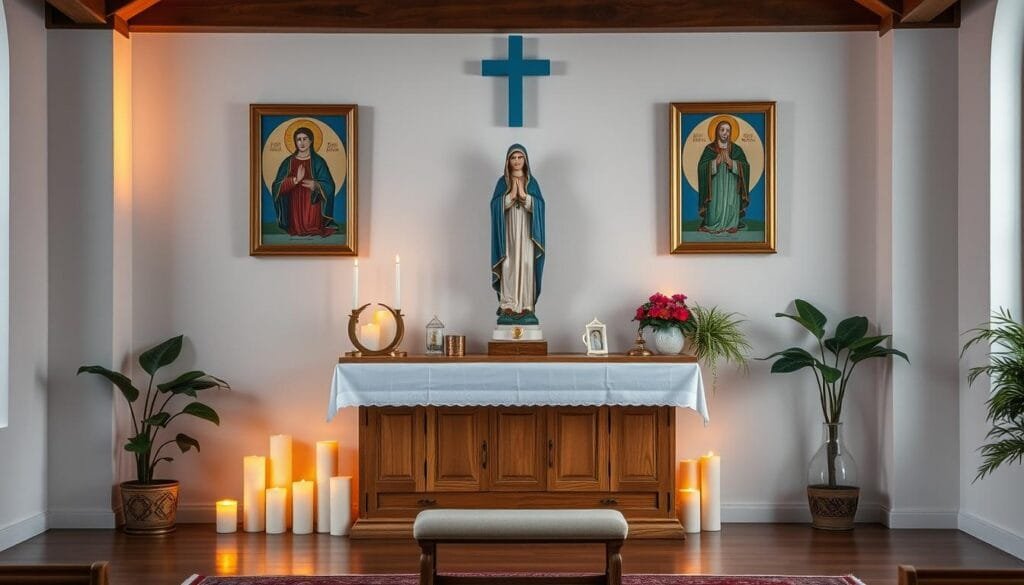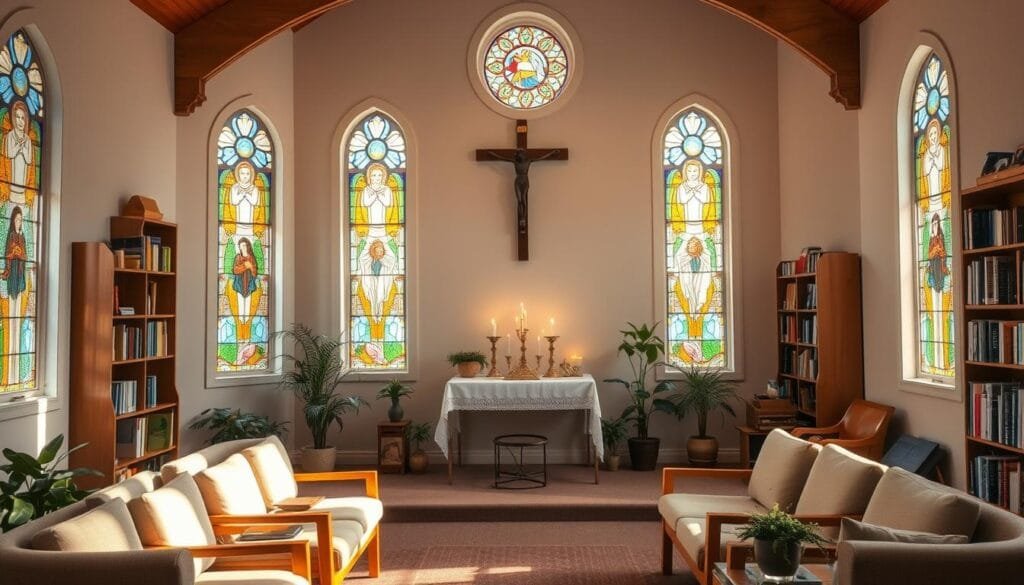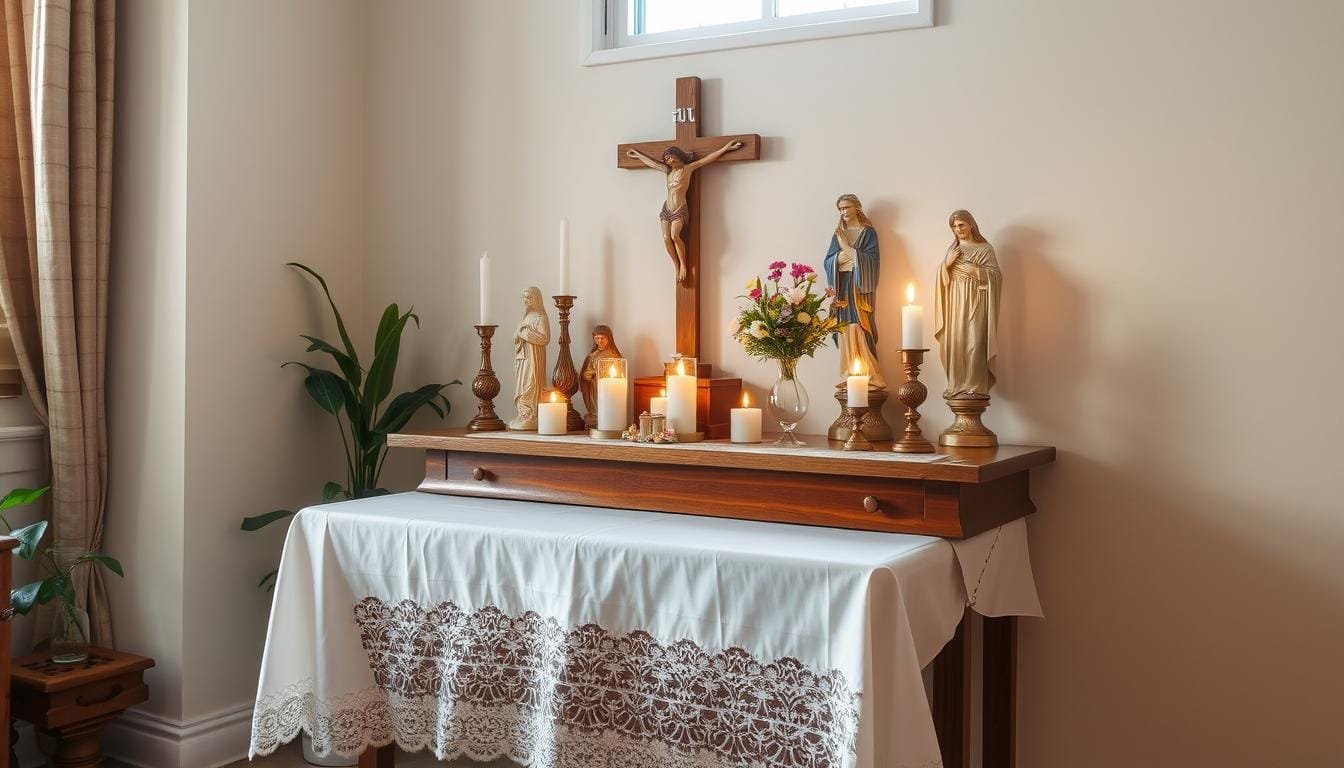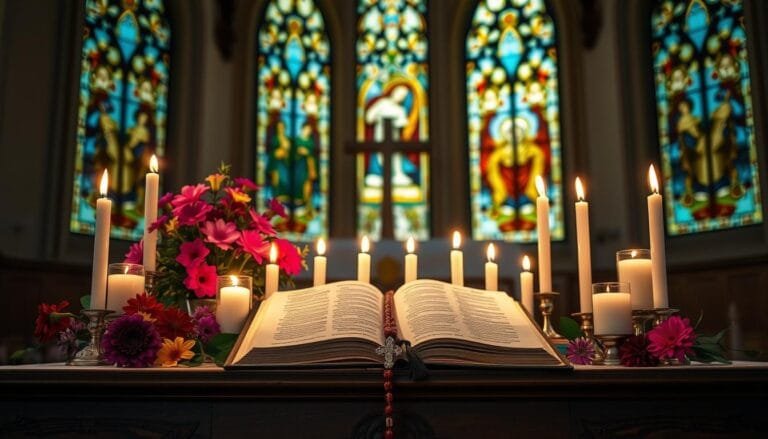10 Ideas For Your Catholic Prayer Room
This website contains affiliate links. As an Amazon Associate, I earn from qualifying purchases. The content on this website was created with the help of AI.
Imagine a peaceful corner in your home for connecting with God. Catholic prayer rooms bring the church’s essence into your living space.
These sacred areas offer a gateway to deeper spiritual devotion.
Catholic home altars are steeped in centuries-old tradition. They keep faith alive beyond Sunday Mass. These spaces serve as focal points for daily devotions and Bible reading.
Podcasts like “The Bible in a Year” by Fr. Mike Schmitz have inspired many. With 1,899 episodes, it’s clear Catholics want to integrate faith into daily life.
A dedicated prayer room is an excellent way to start. It provides a perfect spot for spiritual growth and reflection.
Key Takeaways
- Catholic prayer rooms create a bridge between church and home
- Home altars have deep historical roots in the Catholic tradition
- Sacred spaces foster daily devotion and spiritual reflection
- Prayer corners can be simple or elaborate, suiting various preferences
- Creating a spiritual haven at home enhances personal faith practices
Understanding the Significance of a Catholic Prayer Room
A Catholic prayer room is vital in our faith journey. It’s where we connect with God and grow spiritually. These sacred spaces play a crucial role in Catholic tradition and home worship.
The Historical Roots of Home Altars
Home altars have been part of Catholic life for centuries. They are focal points for family prayer, bringing the church into our homes.
These altars remind us of our faith and help us stay connected to our Catholic roots.
The Spiritual Benefits of Dedicated Prayer Spaces
A special spot for prayer offers many spiritual benefits. It helps us focus and creates a sacred space in our busy lives. A prayer room can be simple or elaborate.
What matters most is that it’s a place where we can grow closer to God. It allows us to deepen our relationship with Him daily.
Creating a Bridge Between Church and Home
A Catholic prayer room connects church and home. It extends our spiritual practices beyond Sunday Mass. Setting up a prayer space brings our faith into daily routines.
This strengthens our Catholic identity and encourages regular family prayer. It helps us live our faith every day, not just on Sundays.
“Our prayer room has become the heart of our home. It’s where we gather as a family to pray, reflect, and grow in our faith together.” – Joe and Kathy Narens, married for 45 years

A Catholic prayer space is a powerful tool for spiritual growth. It reminds us of our faith and invites us to pray more often. This sacred area helps create a home filled with God’s presence.
Essential Elements of a Catholic Prayer Space
A dedicated prayer space at home brings the sacred into our daily lives. Let’s explore key components that make a Catholic prayer room meaningful.
These elements can inspire and deepen your spiritual practice.
Sacred Images and Icons
Catholic icons and religious art form the heart of any prayer space. These visuals help focus our thoughts during prayer.
A crucifix and images of Jesus, Mary, and saints can transform a corner into a sacred sanctuary.
Prayer Materials and Holy Books
Essential prayer materials include the Bible, prayer books, and rosary beads. These tools guide our conversations with God.
Having a dedicated prayer corner with these items encourages regular reflection.
Lighting and Atmosphere
The right lighting creates an atmosphere for prayer. Prayer candles provide soft illumination and symbolize Christ as the light.
For safety, many families opt for flameless candles, especially in homes with children.
Sacred Objects and Sacramentals
Sacred objects like holy water fonts, crucifixes, and blessed items enhance the space’s sanctity. These sacramentals serve as tangible reminders of God’s presence.
They help create a focused environment for prayer and meditation.
| Item | Significance | Percentage of Catholics Using |
|---|---|---|
| Bible | Word of God | 94% |
| Mary Statue | Devotion to Our Lady | 88% |
| Prayer Candles | Christ’s Light | 78% |
| Rosary Beads | Marian Prayer | 85% |
| Crucifix | Christ’s Sacrifice | 92% |
10 Ideas For Your Catholic Prayer Room
A sacred space at home can boost your faith journey. We’ve gathered inspiring prayer corner ideas for your Catholic prayer room. These suggestions fit various preferences and spaces.
1. Sacred Art Focal Point: Choose striking religious art as your room’s centerpiece. A painting of the Sacred Heart or a statue can set the tone.
2. Comfortable Seating: Add a cozy chair or cushions for extended prayer times. This allows for comfortable reflection and meditation.
3. Natural Elements: Add plants or flowers to bring life to your prayer room. This nature connection can enhance the peaceful atmosphere.
4. Lighting Options: Use soft, warm lighting for a serene ambiance. Flameless candles are safe, especially for homes with children.
5. Prayer Wall: Create a wall for intentions, Bible verses, or inspirational quotes. This serves as a reminder of your spiritual goals.
| Item | Purpose | Popularity |
|---|---|---|
| Ignatius Bible | Scripture reading | High |
| Standing Crucifix | Focal point | Very High |
| Holy Water Bottle | Blessing | Medium |
| Prayer Cards | Daily inspiration | High |
| Icons | Spiritual focus | Medium |
6. Altar Design: Make a small altar with a crucifix, candles, and meaningful sacramentals. This becomes the heart of your prayer room.
7. Book Nook: Include a shelf with spiritual books for ongoing faith formation. Works by St. Josemaría Escrivá can be inspiring choices.
8. Icon Corner: Set up a space for icons, a traditional Catholic home decor element. These sacred images can aid in prayer and reflection.
9. Sound Elements: Add a small fountain or wind chimes for a peaceful sound. These can create a calming auditory environment.
10. Personal Touches: Add items that are special to you. Rosaries, prayer cards, or pilgrimage mementos can make the space unique.
These prayer room ideas can help create a nurturing space. They bring Catholic traditions’ beauty into your home, boosting your spiritual life.
Maintaining and Evolving Your Prayer Space Through Liturgical Seasons
Catholic prayer rooms reflect our faith’s rich traditions. By aligning our spaces with the liturgical calendar, we deepen our spiritual journey.

This practice brings Church rhythms into our homes, connecting us to our Catholic heritage.
Seasonal Decorations and Colors
Liturgical seasons add meaning to our family devotions. During Advent, purple fabrics and an Advent wreath can adorn our space.
For Lent, we might drape a cross in purple or display Christ’s passion symbols.
Each season offers unique ways to refresh our prayer environment. These changes help us focus on the current spiritual themes.
Feast Day Celebrations
Catholic feast days honor saints and significant faith events. On September 8th, we might place a Marian statue with white flowers for Mary’s Nativity.
For St. Francis’ feast on October 4th, we could include animal images. This reflects his love for God’s creation.
Family Traditions and Rituals
Family traditions around our prayer space strengthen faith and build memories. We might gather nightly during Advent to light candles and pray together.
During Lent, a prayer jar could encourage sharing intentions. These simple practices help us grow in faith as a family.
| Feast Day | Date | Liturgical Color |
|---|---|---|
| Nativity of the Blessed Virgin Mary | September 8th | White/Gold |
| Exaltation of the Holy Cross | September 14th | Red |
| Feast of St. Matthew | September 21st | Red |
Conclusion
A Catholic prayer room nurtures home prayer life. This sacred space deepens spirituality and strengthens faith. It adapts to unique needs, from military families to parents guiding children.
Prayer room ideas show the power of personalization. Spaces can range from lit closets to corners with religious items. These rooms become catalysts for spiritual growth.
Our homes become extensions of the church community. Children learn to pray, and families unite in devotion. Individuals find solace in quiet reflection.
By creating sacred spaces, we invite God into our daily lives. This fosters a rich Catholic spirituality right at home. Our faith journey becomes more vibrant and meaningful.












